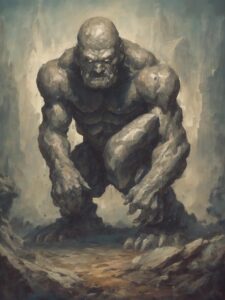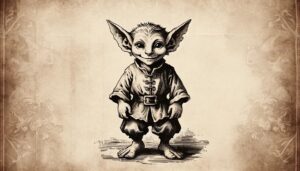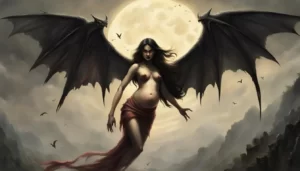Table of Contents
The Origins

In medieval times, Rabbi Judah Loew ben Bezalel, the Maharal of Prague, shaped the Golem’s origins. During times of persecution, he crafted a protective force from clay. Through mystical rituals, the revered figure breathed life into the legendary Golem. Inscriptions, imbued with ancient wisdom, adorned the clay form. The animated guardian stood tall, a silent sentinel against external threats. Rabbi Loew’s ingenious creation fused spirituality with practicality, a testament to his devotion.
The Golem’s purpose extended beyond mere folklore; it became a living shield for the vulnerable. In moments of crisis, the clay behemoth rose, embodying the resilience of the community. Transitioning from Rabbi Loew’s workshop to the streets of Prague, the Golem’s presence became legendary. Its footsteps echoed through cobblestone alleys, a symbol of hope in dark times. As word of the Golem spread, so did its mythic aura, transcending the confines of Prague. The Maharal’s legacy, intertwined with the animated guardian, became a tale told and retold. The Golem’s origins, rooted in clay and mysticism, remain a captivating chapter in the annals of folklore.
Special Powers
The powers and abilities attributed to golems can vary across different legends and adaptations. However, some common characteristics associated with golems include:
Incredible Strength:
Golems are often depicted as possessing immense physical strength. Their sturdy, inanimate bodies are animated to perform tasks that would be impossible for humans.
Immunity to Fatigue and Pain:
Golems, being constructs of clay, stone, or other materials, are typically impervious to fatigue and pain. They can tirelessly carry out their assigned tasks without succumbing to exhaustion.
Resistance to Physical Damage:
Many golem legends portray them as nearly indestructible, resistant to conventional weapons. Their bodies, crafted from durable materials, make them formidable opponents.
Obedience to Commands:
Golems are often created to serve a specific purpose or follow commands from their creators. Their loyalty and obedience make them ideal protectors or assistants.
Limited Sentience:
In some stories, golems exhibit a degree of sentience or consciousness. While not fully human, they may display rudimentary emotions or decision-making abilities, adding complexity to their character.
Creation and Control through Rituals:
Golems are typically brought to life through specific rituals performed by their creators. These rituals involve inscribing mystical words or symbols on the golem’s body, imbuing it with life.
Task-Specific Abilities:
Depending on the purpose for which they are created, golems may possess specific abilities related to their designated tasks. For example, a golem crafted for protection may have heightened vigilance or defensive capabilities.
Elemental Affiliation:
In certain traditions, golems are associated with specific elements, such as clay, stone, or mud. This elemental connection may influence their abilities and characteristics.
It’s important to note that the depiction of golems can vary widely, and not all stories attribute the same powers to these creatures.
Legends and Stories

Various legends surround golems, with one of the most well-known originating from Jewish folklore.
Jewish Folklore – The Golem of Prague:
Legend has it that Rabbi Judah Loew ben Bezalel created a golem in the 16th century to protect the Jewish community in Prague. The golem, brought to life through the Rabbi’s rituals, became a silent guardian against persecution.
Germanic Legends – The Clay Giant in the Kabbalistic Tradition:
In Germanic legends, a clay giant emerges, drawing inspiration from the Kabbalistic tradition. Crafted with meticulous detail, the giant comes to life through ancient rituals. The earthy colossus stands sentinel, symbolizing both protection and awe. Its creation, a harmonious blend of mysticism and craftsmanship, reflects the intricate tapestry of Germanic folklore. As the legend unfolds, the giant’s role expands beyond the mundane, intertwining with the spiritual essence of its origins. Tales of this clay behemoth resonate, carrying echoes of Kabbalistic wisdom and the timeless power imbued in the earth’s raw elements.
Polish Folklore – The Mud Monster of Chelm:
In Polish folklore, the Mud Monster of Chelm rises from the earth, a creature fashioned from mud. The bumbling monster, endowed with life through inexplicable means, wreaks havoc in the quaint town. Villagers, initially perplexed, soon find humor in the monster’s misadventures. As the mud creature stumbles through the streets, laughter ensues, turning fear into amusement. Transitioning from chaos to camaraderie, the Mud Monster becomes a symbol of communal resilience. Its muddy escapades weave a tale of lightheartedness amid the folklore of Chelm, showcasing the enduring power of laughter in the face of the unexpected.
Cinematic and Artistic Representations:

Modern Literature – Mary Shelley’s “Frankenstein”:
Mary Shelley’s “Frankenstein” revolutionizes literature as Victor Frankenstein defies natural order, creating life from lifelessness. Driven by ambition, Victor’s creation becomes a tragic figure, yearning for acceptance. Additionally, transitioning from the laboratory to society, the creature confronts humanity’s rejection. Shelley’s narrative delves into the consequences of playing god, questioning the ethical boundaries of scientific pursuits. Furthermore, amid Gothic landscapes, the tale unfolds, weaving themes of hubris, responsibility, and the haunting impact of unchecked ambition. Ultimately, “Frankenstein” stands as a timeless exploration of the human desire for creation and the unforeseen ramifications that echo through generations.
Terry Pratchett’s “Feet of Clay”:
Czech Cinema – “The Emperor’s Baker – The Baker’s Emperor” (Císařův pekař – Pekařův císař):
In “The Emperor’s Baker – The Baker’s Emperor,” Czech cinema weaves a whimsical tale of a golem. Crafted to bake, the golem transcends its culinary role, embracing a journey of self-discovery. Furthermore, transitioning from the bakery to the emperor’s court, the golem’s adventures unfold. Amidst laughter and surreal landscapes, the film explores themes of identity and purpose. Additionally, Czech cinema, with its unique storytelling, transforms the traditional golem narrative into a delightful cinematic experience, blending fantasy with profound insights. Thus, “The Emperor’s Baker – The Baker’s Emperor” stands as a testament to the enduring charm of the golem motif, capturing the imagination through the lens of Czech creativity.
FAQ




